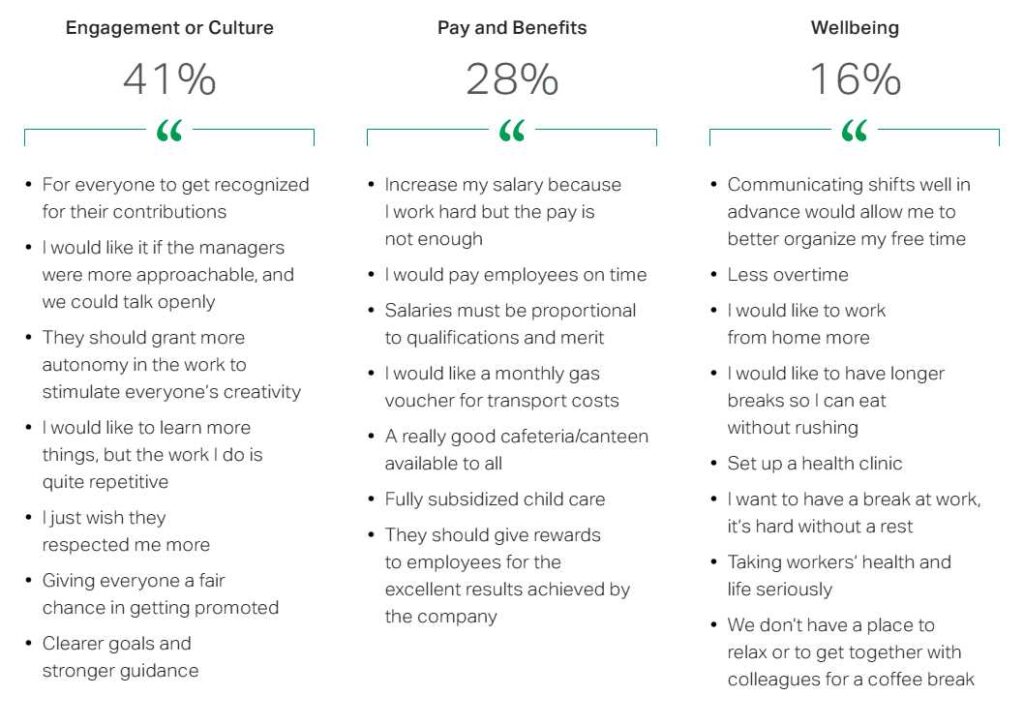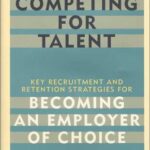If there is one reoccurring theme amongst my clients who operate employee-based businesses, it is the struggle they face in recruiting and retaining their employees. All too often, they add that they also suffer from customer service issues simply because they can’t allocate sufficient resources to the work they already have. All this should come as no real surprise since, according to Business News Daily, 60.7% of small business owners say hiring the right talent is a top challenge, while 45.8% report difficulty retaining existing staff as well. The power dynamics in the workplace have clearly shifted, and employers who can recognize and adapt to these changes have a great opportunity for success.
We have all heard about the Great Resignation after the pandemic, where employees left the workforce. However, the issue most discussed in business articles lately is how the Great Resignation has morphed into the Great Reshuffle. In the Great Reshuffle, employees are not leaving the workforce as they did in the Great Resignation. Instead, they are quitting their jobs for employment with another company with a better corporate culture.
Research suggests that, amid the ongoing Great Reshuffle, businesses are struggling with unprecedented employee turnover, fueled primarily by employee dissatisfaction. It’s evident that traditional retention strategies are falling short.
“The research shows a significant disconnect between why people leave a job and why their bosses think they leave,” says Stacy Cook, principal of Perception Learning, a leadership development consultancy. “The bosses usually assume people leave because they want more money or better benefits. But the people who leave rarely say that. They say they are seeking greater opportunities for professional growth, more meaningful work, and a sense that their efforts are appreciated.”
In fact, recent data from the U.S. Department of Labor and Gallup’s State of the Global Workplace reports highlight the pressing need for a comprehensive approach to address the root causes of disengagement and unhappiness among employees.
Gallup’s data underscores the pivotal role of managers in shaping the employee experience. A staggering 70% of the variation in team engagement is attributed to managers, making them crucial players in fostering a positive work environment. Beyond the typical work-focused aspects, managers must engage in consistent, meaningful discussions with employees, understanding their goals, strengths, and work-life blend. The transition from delegating managers to coaching managers is becoming paramount in fostering trust and overall well-being.
According to the research, organizations must prioritize meaningful interactions with their employees. A fundamental step is ensuring managers engage in at least one meaningful weekly conversation with each of their direct reports. Redefining managerial roles, providing training and resources, and establishing evaluation mechanisms have become essential components of this transformation. The aim is to create a workplace where employees feel more valued and supported.
Investing in employee engagement goes beyond just demonstrating concern for employees; it also has tangible benefits for the organization. Gallup’s findings reveal that business units with engaged workers experience a remarkable 23% higher profit. On the flip side, disengaged workers cost the global economy $7.8 trillion in lost productivity. In the current landscape of the Great Reshuffle, the focus on job satisfaction is not just about attracting new talent but retaining existing employees as well.
Meaningful Recognition Trumps Compensation
Recognizing the limitations of traditional retention tactics, the Achievers Workforce Institute’s survey introduces a powerful strategy. The survey engaged over 4,200 employees and 1,600 HR leaders globally, unveiling the transformative impact of meaningful recognition on engagement, loyalty, and overall employee satisfaction.
The survey challenges the notion that a simple “Thank you” suffices as recognition. Employees want more than generic acknowledgment; they yearn for specifics on how their efforts have contributed to projects or had a positive impact on their colleagues. Natalie Baumgartner, Chief Workforce Scientist at Achievers, emphasizes the importance of personal and impact-oriented words of praise. Regular recognition correlates with greater job commitment, with 65% of respondents expressing that feeling recognized reduces their inclination to job hunt.
Gallup asked, “What would you change about your workplace to make it better?” The following chart summarizes their responses.

In a paradigm shift, the survey challenges the belief that a salary increase is the primary driver of employee commitment and productivity. Recognition has surpassed the perception of a fair salary’s impact on the workforce. 52% of employees state that feeling recognized for their work would mitigate the adverse effects of a salary freeze. This insight underscores the need for organizations to look beyond salary and benefits as the primary recruitment and retention tool.
Managerial Training Gap
Despite recognition’s significance, there is a substantial gap in managerial training around recognition techniques. While 90% of companies claim to offer recognition training, only 41% of employees report receiving it. Moreover, a mere one-third of those trained received instructions on how to deliver meaningful recognition. This discrepancy highlights a critical need for regular training on best practices in recognition, addressing aspects such as frequency, timing, and the value-based specificity of acknowledgment.
The role of managers in shaping workplace culture cannot be overstated. Employees who are frequently recognized by their managers are more likely to reciprocate, creating a positive chain reaction. With 48% of employees citing a deterioration in workplace culture during the pandemic, businesses must empower managers with the tools and encouragement they need to effectively recognize their employees.
Web-based employee recognition software platforms enable many organizations to acknowledge and reward their employees for their contributions and achievements. Here is a list of the 21 web-based employee recognition software platforms according to SnackNation.
The research also reveals that a staggering 64% of employees express a preference for more meaningful recognition over frequency. Businesses should invest time and resources in building comprehensive recognition training programs. This investment enhances retention statistics and contributes to a positive workplace culture, making the organization more attractive to new talent.
As organizations grapple with the aftermath of the Great Reshuffle and the decline of workplace culture, a focus on recognition is emerging as a strategic imperative for organizations that want to be viewed as employers of choice. According to Nancy S. Ahlrichs’s book “Competing for Talent,” an employer of choice can meet their growth and profit goal by attracting and retaining the quantity and quality of employees they need.
Employee Engagement Best Practices
Employee engagement describes how employees invest their energy (behavioral, cognitive, and emotional) in positive outcomes within your organization. Employee engagement goes beyond employee happiness or satisfaction, focusing on their motivation levels, emotional commitment, and involvement in their work. Milton Herman of LumApps developed a list of 30 employee engagement best practices businesses can employ, summarized below.
- Encourage Manager Buy-in
- Leaders, especially managers, must prioritize employee engagement.
- Manager engagement sets the tone for successful practices.
- Communicate Regularly
- Prioritize one-on-one meetings with each employee.
- Managers gain insight, and employees feel empowered.
- Provide Feedback
- Regular performance conversations and surveys are vital.
- Feedback tools enhance employee engagement strategies.
- Make Strategy a Priority
- It is crucial to have a clear engagement strategy.
- Without strategy, morale diminishes, hindering innovation and productivity.
- Communicate Objectives
- Top-down communication of company goals is essential.
- Clear expectations drive employee engagement.
- Measure Engagement
- Regular surveys gauge understanding and morale.
- Metrics identify strengths and areas for improvement.
- Recognition Programs
- Acknowledge personal and professional milestones.
- Virtual platforms enhance recognition in remote settings.
- On-the-Spot Recognition
- Immediate acknowledgment reinforces positive behavior.
- Fits the expectations of the modern, instant-gratification workforce.
- Set Expectations
- Clear expectations are vital for employee success.
- Employees need to know their role and how to exceed expectations.
- Discover Employee Motivations
- Satisfaction surveys and clearly defined career paths are crucial.
- Flexible work arrangements are a significant motivator.
- Executives Set Examples
- Managers must embody engagement principles.
- Senior leadership commitment is essential for success.
- Conduct Stay and Exit Interviews
- Address needs before dissatisfaction grows.
- Explore motives to enhance retention strategies.
- Offer Assistance
- Managers should provide support in professional and personal matters.
- Confidentiality reassures employees seeking help.
- Immediate Recognition
- Immediate feedback reinforces positive contributions.
- Waiting reduces the impact of recognition efforts.
- Diverse Rewards
- Vary rewards to cater to diverse employee preferences.
- Change options regularly to maintain interest.
- Share on Social Media
- Public acknowledgment on social media boosts morale.
- Positive posts showcase company achievements.
- Invest in Management Training
- Managers play a vital role in employee experience.
- Training ensures alignment with company values.
- Be Transparent
- Openness fosters trust and honesty.
- Balance transparency with necessary confidentiality.
- Start Engagement Early
- Initiate engagement practices during onboarding.
- Set expectations from the beginning.
- Focus on Health and Wellness
- Employee well-being is integral to engagement.
- Wellness programs contribute to a healthy workforce.
- Healthy Work Environment
- Establish policies against bullying and harassment.
- Communication training enhances positive interactions.
- Encourage Collaboration
- Cross-functional collaboration promotes teamwork.
- Utilize collaboration tools and team-building activities.
- Embedding Company Culture
- Engagement practices should be ingrained in the culture.
- Constant communication is key for engagement.
- Customized Engagement
- Tailor strategies to the unique needs of employees.
- Individualized approaches enhance effectiveness.
- Careful Hiring
- Attitude and cultural fit are as crucial as skills.
- Prioritize candidates willing to learn and adapt.
- Support Career Advancement
- Support employees in their career goals.
- Provide training and tools for skill development.
- Add Fun to the Workplace
- Infuse fun activities to combat monotony.
- Trivia quizzes and prize draws maintain employee interest.
- Identify Star Employees
- Recognize and reward outstanding contributions.
- Promote exemplary employees for motivation.
- Invest in Modern Technology
- Updated technology enhances work efficiency.
- Modern intranets and communication tools are essential.
- Persist in Engagement Processes
- Engagement is a gradual, ongoing process.
- Patience is key; consistency fosters lasting change.
Conclusion
In navigating the challenges of the Great Reshuffle, organizations must embrace a multifaceted approach. Recognition and management training allow organizations to level up their employee engagement, which is the key to recruiting top talent, retaining them, and getting the business recognized as an employer of choice.
Businesses can transform their workplace culture by prioritizing effective management practices and incorporating meaningful recognition strategies. The imperative is not only to retain current talent but to become beacons that attract the most talented employees in the job market.
How will you implement employee engagement programs and level-up manager training to make your business an employer of choice?












